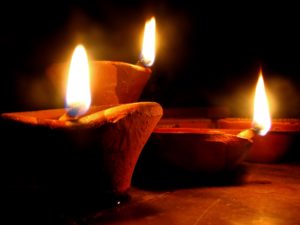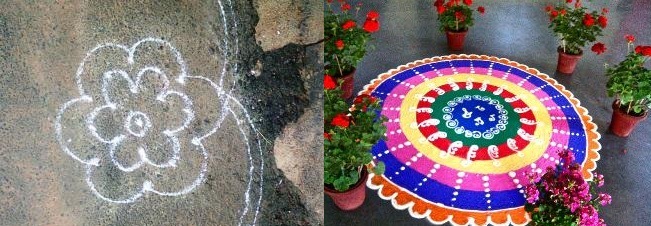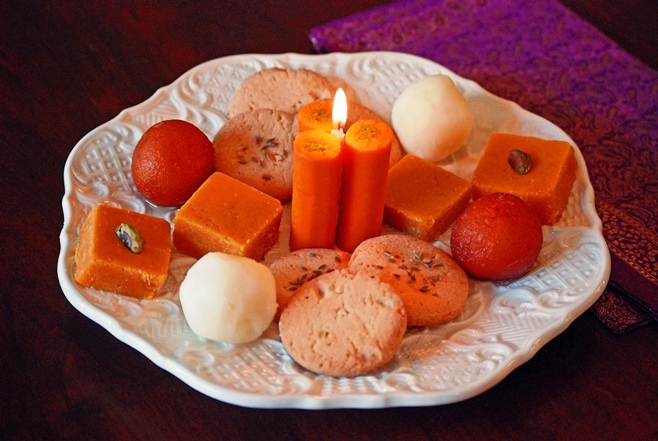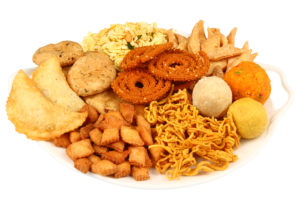
Many things are celebrated on Diwali, but the overarching reason for the holiday for Hindus is to commemorate the return of Lord Rama from his long exile and his triumph over the demon-king Ravana. To welcome Rama, people clean and decorate their homes and businesses, dress in new clothes, perform religious rituals (puja), and feast on sweet and savory snacks and light firecrackers to frighten evil spirits away.
Although traditions vary by geographic location and ethnicity, generally speaking, on the first day, Hindus celebrate the return of prosperity to the earth. In many places cows and calves are worshipped or given special consideration, and for many Indian businesses, this is also the first day of the new financial year. Today (the second day) commemorates the birth of Dhanvantari, the Physician God and is an auspicious day to make certain purchases. Tomorrow, the third day, celebrates Krishna’s defeat of the demon Narakasura and in preparation for a Krishna/Vishnu puja, oil lamps are lit and elaborate ritual artworks called kolams or rangolis are prepared. These rangoli can either be simple decorations of powdered rice or grain or elaborate mandala-like geometric patterns made with multi-colored sand or flour or even flower petals. People often get up before sunrise to bathe under the stars and after worship feasting and visiting family and friends begins.

On the fourth day, the Lakshmi puja celebrates the Goddess Lakshmi and the God Ganesh and renewed prosperity is once again celebrated. The fifth day is day is celebrated as Govardhan puja or Annakoot, and is celebrated as the day Krishna defeated Indra and by the lifting of Govardhana hill to save his kinsmen and cattle from rain and floods. In some places on this day, mountains of food are piled up and decorated symbolizing the earth lifted by Krishna. The day after Diwali is a special celebration for brothers and sisters, with the women and girls traditionally making and serving their brother’s favorite foods and receiving gifts from their brothers in return.
For Jains, Diwali has a very different meaning. It is celebrated as the day Lord Mahavira, the last of the Jain prophets of this era, attained nirvana. To the Jains, the name for the celebration, Dipalikaya roughly translates as “light leaving the body”. Hence the thousands of lamps lit during these holidays are seen as “souls” to the Jains. The Jain New Year begins after Diwali celebrations conclude.

For Sikhs, Diwali is particularly important because it celebrates the release from prison of the sixth guru, Guru Hargobind, and 52 other princes with him, in 1619. Having been imprisoned by Emperor Jahangir, the guru was to be released but begged for clemency for the 52 princes that had been imprisoned with him. The emperor declared that only those princes who could hold onto the guru’s cloak could leave with him. In a brilliant ruse, the guru made a cloak with 52 pieces of string to allow all the princes to grab onto the cloak and exit with him. Today, the Sikhs celebrate the return of Guru Hargobind by lighting their Golden Temple and other Sikh places of worship around the world.
The many sweets enjoyed at this time of year are called mithai* and are made from a ground of chickpea flour, rice flour, semolina, various beans, lentils and grains, squashes, or carrots, thickened condensed milk or yoghurt. These ingredients are then pounded together or cooked and flavored with cashews, almonds, pistachios, or raisins. Other ingredients can include fragrant spices like cardamom, cinnamon, cloves, nutmeg or cumin or kewra (pandan leaf essence). The fanciest of the sweets can contain silver or gold leaf design elements as well. Households cook and exchange elaborately decorated boxes of these sweets with family and friends as part of the Diwali celebrations.

Recipes for Diwali snacks are available in the Silk Road Gourmet Volume One in the Pakistan, India and Sri Lanka chapters and include: Pastry in Sweet Milk and Rosewater (Ras Malai), Sweet Milk Squares with Cardamom, Cinnamon and Almond Custard, Semolina Squares with Saffron and Cardamom, Sweet Split-Pea Pudding and Sweet Coconut-Cardamom Balls. Additional recipes will be available in the next volume of the book as well.
(Words and Photo of A Selection of Diwali Snacks by Laura Kelley; photo of Tradtional Diwali Lamps by The Final Miracle@Dreamstime.com, and photo of Savory Diwali Snacks by Ashwin Abhirama. Individual images for the photo simple and complex rangolis are from Wikimedia Commons.)
*Please notice the root “mith” as in Mithras (or Mithrandir for fantasy fans) to denote the connection to fire and light as in Zoroastrianism.
